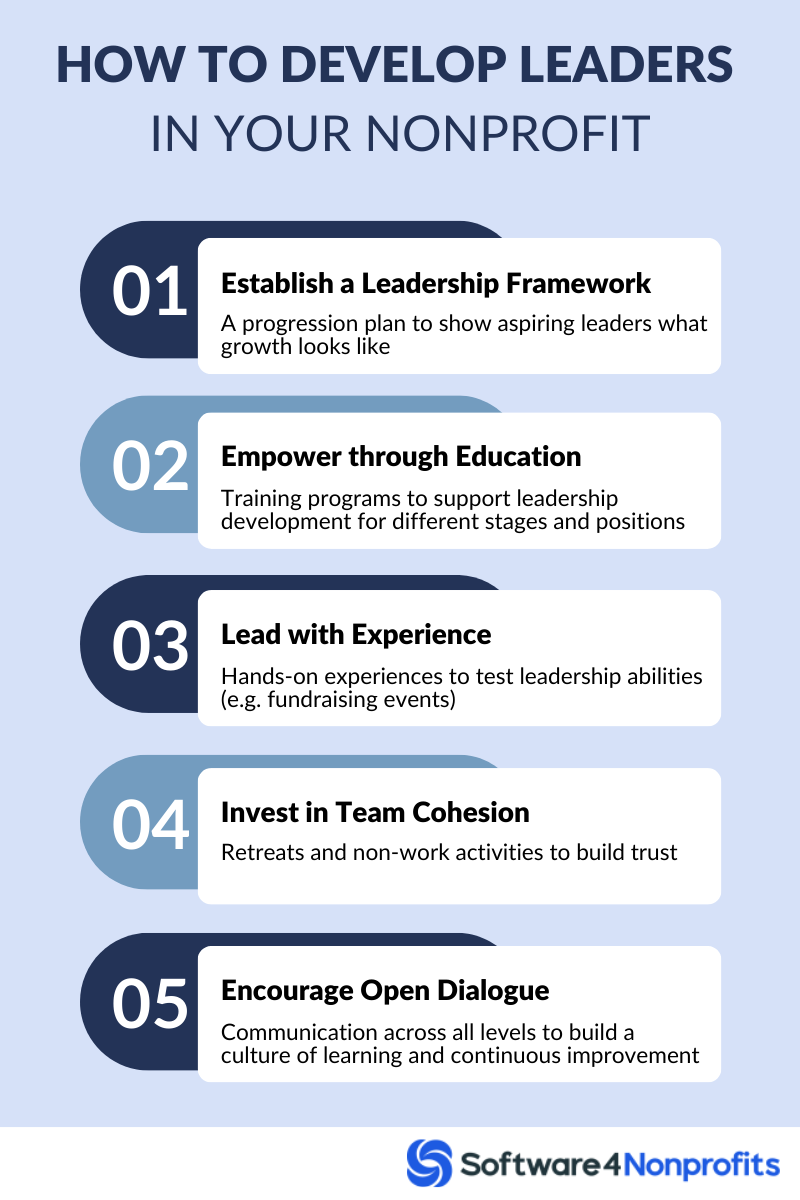Leading a nonprofit organization presents a unique set of challenges and opportunities. While rooted in purpose and passion, leaders must master the intricacies of stakeholder engagement and resource management to truly drive impact.
Why is Leadership Development Crucial for Nonprofits?
Starting a nonprofit is fueled by a compelling vision and a sense of mission, but realizing that vision demands effective leadership.
Guiding a nonprofit requires assembling a dedicated team, setting actionable goals, and supervising both triumphs and setbacks. Concurrently, leaders are entrusted with the tasks of elevating the organization’s profile and securing the financial support crucial for long-term sustainability.
From Volunteerism to Professional Leadership
In the early stages, many nonprofits depend on volunteer leaders, but as they expand, the recruitment and development of skilled leadership become essential.
Staff in the nonprofit sector often transition from diverse professional backgrounds. Investing in continuous learning and leadership development can yield significant benefits for the organization, enhancing both performance and job satisfaction.
Lastly, focusing on succession planning and equipping both staff and volunteers for future leadership roles can mitigate transition challenges, ensuring the organization’s continued success.
Steps to Elevate Leadership in Your Nonprofit Organization
1 – Establish a Comprehensive Leadership Training Framework
Every initiative or endeavor requires a well-structured plan, and leadership cultivation is no exception. Consider laying the foundation with a comprehensive leadership training framework. This framework should present systematic procedures for all involved, articulate objectives, and ensure equitable recognition for the time and commitment of each participant. By adhering to such a structured approach, participants can expect transparent communication and an environment fostering mutual appreciation.
2 – Empower Through Education
Central to any leadership development initiative are the educational avenues provided for growth. When the budget permits, consider endorsing external training sessions or conferences for select team members.
Such endorsements not only enhance skill sets but also convey a message of trust and investment in their professional journey. For those operating on tighter budgets, online webinars present an economical alternative. Numerous cost-effective and complimentary webinars cater to various roles and responsibilities. Allocating time and resources for staff to engage in these online sessions reinforces a culture of continuous learning and employee satisfaction.
3 – Cultivating Leaders through Practical Experience
The journey of leadership development extends beyond formal education. Real-world, on-the-ground experiences often lay the strongest cornerstones for budding leaders.
Take nonprofit fundraising activities, for instance. They are replete with such experiential learning moments. Here are some avenues:
- Encouraging staff and volunteers to assume leadership positions during events.
- Empowering volunteers to spearhead their unique campaigns, both digitally and offline.
- Allowing staff to nurture relationships with key donors on a personal level.
Begin by entrusting them with minor responsibilities and gauging their execution. In your emerging leaders, you’d ideally want to recognize:
- Proactiveness and a sense of ownership.
- Teamwork is anchored in positivity and collaboration.
- A knack for strategic planning.
- Robust networking skills and effective team communication.
Once these attributes are evident, it’s a cue to entrust them with larger, more impactful roles.
4 – Foster Leadership through Team Cohesion
A potent method to identify and nurture potential leaders while instilling a culture of leadership is via team-building endeavors.
Consider organizing periodic retreats for your nonprofit, be it annually or at intervals throughout the year. These retreats can encompass a medley of activities – from brainstorming challenges, collaborative training sessions, and inspirational speakers to engaging team games.
Integrating the entirety of your staff in such initiatives deepens interpersonal bonds and facilitates seamless transitions anchored in mutual trust.
Kickstarting such efforts with team-based fundraising can be immensely beneficial. It not only raises funds but also paves the way for the emergence of accountable leaders within your fold!
5 – Encourage a Culture of Open Dialogue
Actively seeking insights and suggestions from your volunteers, prospective leaders, and staff is pivotal. Ensure that this practice of open communication permeates all levels of your nonprofit, from the highest echelons to the grassroots.
By doing so, you instill a sense of ownership and trust within them. This, in turn, motivates team members to take the initiative and assume a more pronounced role within the organization.

Best Leadership Practices for Lasting Impact
Embarking on the journey to cultivate a leadership ethos within your nonprofit? It’s crucial to delineate the practices that empower leaders to drive genuine and enduring change within the organization. How can your leaders truly resonate with the organization’s mission and amplify its impact? Let’s delve into these best practices.
1 – The Power of Guidance: Implementing Mentorship
Mentorship stands as a priceless yet profoundly transformative practice for leaders in the nonprofit sector. As the organization’s figurehead, initiating mentorship with your direct reports can set a powerful precedent.
The approach to mentorship may vary from one organization to another; some may adopt structured, regular meetings, while others may opt for a more informal touch. Regardless of the format, the objective remains consistent: to establish an uplifting and encouraging atmosphere that incentivizes others to become mentors as well.
Consider extending mentorship programs to encompass not just staff but also board members and volunteers, diversifying the scope and impact of your guidance.
2 – Navigating Staff Transitions
Experiencing the departure of a valued employee can evoke mixed emotions. While it’s natural to feel a sense of loss, it’s equally vital to celebrate their growth and maintain a positive rapport.
In the unpredictable realm of nonprofits, today’s employees and volunteers can be tomorrow’s donors or advocates. Their post-departure perceptions of your organization could influence its reputation, for better or worse. The manner in which you handle and respond to such transitions can be pivotal.
To safeguard against potential disruptions stemming from unexpected departures, it’s prudent to have a succession plan in place. Being proactive and prepared can significantly ease the transition phase and ensure organizational continuity.
3 – Creative Recruitment
Given budget constraints, nonprofits often can’t compete with higher-paying sectors when it comes to attracting top-tier talent. This necessitates an unconventional approach to recruitment, compelling organizations to identify standout candidates based on unique criteria.
Before embarking on the hiring process, clarity on organizational objectives is crucial. Ponder over key questions like:
- What is the envisioned growth trajectory for this role?
- What core competencies are indispensable for this position?
- Could this role serve as a gateway to other opportunities within the organization?
Armed with these insights, you can more effectively identify candidates whose skills align with your needs, considering both trainable attributes and non-negotiable skill sets.
Always remain vigilant for prospective team members who meet these criteria, and make efforts to engage and maintain contact with them. This proactive approach ensures you’re well-positioned to attract the right talent when the need arises.
4 – Championing DEI
Diversity, Equity, and Inclusion (DEI) are not merely trending buzzwords; they represent an imperative for nonprofits aiming for holistic growth. Embracing a diverse workforce and actively dismantling entrenched biases within the organization is pivotal to fostering dynamic leadership.
This arena, too, demands innovative thinking. For instance, those who benefit directly from your nonprofit’s services often bring invaluable perspectives and can make impactful board members if empowered to join the conversation.
Incorporating DEI initiatives requires a well-structured approach. As you weave these principles into your organization’s fabric, prioritize establishing a framework that underscores honesty and transparency, ensuring that all discussions and actions surrounding diversity are rooted in authenticity.
5 – Embracing Volunteering: Gaining a Multi-Faceted View
For leaders to truly grasp the essence of their nonprofit, adopting varied vantage points is indispensable. Every leader in the organization should actively participate in volunteering during events and champion the organization’s mission.
Such hands-on involvement allows team members to immerse themselves in diverse conversations, exposing them to perspectives they might not encounter in their usual roles. This enriches their understanding, enabling them to address concerns more holistically and empathetically.
6 – Openness in Objectives
Building a foundation of trust within a nonprofit hinges significantly on transparency. Right from the outset, it’s crucial to communicate the organization’s overarching goals and strategic vision to all staff and volunteers.
Whether you choose to incorporate this in formal orientation sessions or adopt a more informal approach, ensuring everyone is on the same page is vital. Encourage feedback and solicit suggestions on achieving these goals, fostering a collaborative spirit. Integrating this ethos into your website and regular meetings further reinforces the message.
Such transparent practices, coupled with a receptiveness to diverse viewpoints, instill a sense of enthusiasm and commitment among team members, driving them to contribute wholeheartedly to the cause.
7 – Immediate Recognition
While annual and quarterly evaluations are conventional in many organizations, there’s undeniable merit in offering immediate feedback to both employees and volunteers.
Addressing concerns or acknowledging commendable performance in real time ensures that issues are nipped in the bud and exemplary work is promptly recognized. This approach prevents the buildup of discontent and avoids potential escalations.
Continuous feedback not only sustains employee engagement but also fortifies the bond between leaders and their teams. As you sculpt the future of your organization, maintaining regular check-ins with your staff about their progress becomes an invaluable tool for growth and cohesion.
8 – Prioritizing Internal Communication
While most nonprofits meticulously curate communication strategies for donors, members, and the general public, the internal dialogue with staff and volunteers often takes a backseat. Overlooking this crucial cohort could mean missing out on harnessing their full potential.
Remember, staff and volunteers are intimately acquainted with your organization’s workings and are intrinsically motivated to champion its cause. They are not just contributors; they are stakeholders.
Crafting a dedicated communication strategy for them, peppered with regular updates and avenues for feedback, is paramount. Such a proactive approach not only deepens their connection with the nonprofit but also motivates them to assume more influential roles, ensuring their continued association and advocacy, even beyond their tenure.
Conclusion
In the ever-evolving world of nonprofit management, holistic leadership strategies, from innovative fundraising to transparent communication, are paramount. Such approaches not only cultivate visionary leaders but also drive organizations towards lasting impact and growth.



